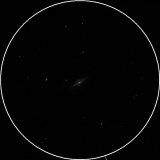
| MESSIER 104 |
|---|
RA: |
12h 40m 00s |
|
DEC: |
-11° 37' 00'' |
|
Type: |
Spiral galaxy |
|
NGC: |
4594 |
|
Magnitude: |
8.00 |
|
Surface brightness : |
11.60 |
|
Apparent dimensions : |
8.6'x4.2' |
|
Distance: |
50,000,000 ly |
|
M104 is numerically the first object of the catalog which was not included in Messier's originally published catalog. However, Charles Messier added it by hand to his personal copy on May 11, 1781, and described it as a "very faint nebula." It was Camille Flammarion who found that its position coincided with Herschel's H I.43, which is the Sombrero Galaxy (NGC 4594), and added it to the official Messier list in 1921. This object is also mentioned by Pierre Méchain as his discovery in his letter of May 6, 1783. William Herschel found this object independently on May 9, 1784. This brilliant galaxy was named the Sombrero Galaxy because of its appearance. According to de Vaucouleurs, we view it from just 6 degrees south of its equatorial plane, which is outlined by a rather thick dark rim of obscuring dust. This dust lane was probably the first discovered, by William Herschel in his great reflector. This galaxy is of type Sa-Sb, with both a big bright core, and as one can see in shorter exposures, also well-defined spiral arms. It also has an unusually pronounced bulge with an extended and richly populated globular cluster system - several hundred can be counted in long exposures from big telescopes. M104 is the dominating member of a small group of galaxies, the M104 group or NGC 4594 group of galaxies. M104 is a real showpiece in 8" telescope. Dust lane can be easily viewed on nights with good contiditions. |
||
Other sketches |
|||||
 |
|||||
M104, Apr 2006. |
|||||
VEDRAN VRHOVAC© 2006.-2007. |
